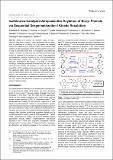Isothiourea-catalyzed atropselective acylation of biaryl phenols via sequential desymmetrization/kinetic resolution
Abstract
Axially chiral phenols are attractive targets in organic synthesis. This motif is central to many natural products and widely used as precursors to, or directly, as chiral ligands and catalysts. Despite their utility few simple catalytic methods are available for their synthesis in high enantiopurity. Herein the atropselective acylation of a range of symmetric biaryl diols is investigated using isothiourea catalysis. Studies on a model biaryl diol substrate shows that the high product er observed in the process is a result of two successive enantioselective reactions consisting of an initial enantioselective desymmetrization coupled with a second chiroablative kinetic resolution. Extension of this process to a range of substrates, including a challenging tetraorthosubstituted biaryl diol, led to highly enantioenriched products (14 examples, up to 98:2 er), with either HyperBTM or BTM identified as the optimal catalyst depending upon the substitution pattern within the substrate. Computation has been used to understand the factors that lead to high enantiocontrol in this process, with maintenance of planarity to maximize a 1,5‐S•••O interaction within the key acyl ammonium intermediate identified as the major feature that determines atropselective acylation and thus product enantioselectivity.
Citation
Munday , E S , Grove , M , Feoktistova , T , Brueckner , A C , Walden , D , Young , C M , Slawin , A M Z , Campbell , A , Cheong , P H-Y & Smith , A D 2020 , ' Isothiourea-catalyzed atropselective acylation of biaryl phenols via sequential desymmetrization/kinetic resolution ' , Angewandte Chemie International Edition , vol. Early View . https://doi.org/10.1002/anie.201916480
Publication
Angewandte Chemie International Edition
Status
Peer reviewed
ISSN
1433-7851Type
Journal article
Description
We would like to thank the Engineering and Physical Sciences Research Council, University of St Andrews, and the EPSRC Centre for Doctoral Training in Critical Resource Catalysis (CRITICAT) for financial support [Ph.D. studentship to E.M.; Grant code: EP/L016419/1]. A.D.S. thanks the Royal Society for a Wolfson Research Merit Award. We also thank the EPSRC UK National Mass Spectrometry Facility at Swansea University. PHYC gratefully acknowledges financial support from the Bert and Emelyn Christensen and Vicki & Patrick F. Stone families. PHYC, MAG, TF, ACB, and DW acknowledge the National Science Foundation (NSF, CHE-1352663). TF acknowledges Summer Fellowship Award from the department of Chemistry at OSU.Collections
Items in the St Andrews Research Repository are protected by copyright, with all rights reserved, unless otherwise indicated.

